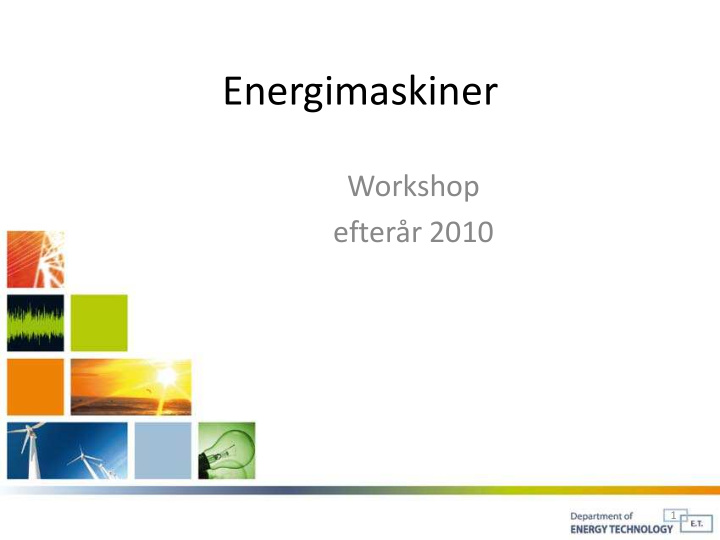



Energimaskiner Workshop efterår 2010 1
Program • 08:15-09:30 Forelæsning • 09:30-14:00 Miniprojekt i grupper • 14:00-15:00 Fremlæggelse i plenum 2
Forlæsning • Carnot • Sterling (m. demo)
Miniprojekter Varmepumpe Benzin motor Diesel motor Kraftværk Refrigerator, heat Otto cycle Diesel cycle Rankine cycle pump Mindre emner: Pumpe, turbine, kompresser, drøvle ventil (throttling valve), • Intercooler, regenerator, varmeveksler
Præsentation • 10-30 min, 1-2 personer 1. Beskrivelse af systemet væsentlige komponenter 2. Beskriv systemet i PV-diagram 3. Angiv typiske effektivitet 4. Andet…Fordele og ulemper…
First little history
External combustion engine • Papins “pressure cooker” – Steam can move a piston – valves • Savery (1698) firsts steam engine – Horsepower – Draining mines – http://library.thinkquest.org/C006011/english/jsit es/steam_thomas_savery.php3?f=2&b=50&j=1&fl =1&v=2
External combustion engine • Newcomens steam engine – 1712
External combustion engine • Watts 2 nd steam engine – Double piston stoke – 1775
Steam locomotives • From 1804
Steam turbines
Sterling engines • Sterling (1820) • http://library.thinkquest.org/C006011/english /sites/stirling.php3?f=2&b=50&j=1&fl=1&v=2
Internal combustion engine • Two stroke engine
Internal combustion engine • 1862 Otto - two stroke • 1879 Benz - first car • 1892 Diesel – compression ignition and many more people should be mentioned…
End of history lesson
Sterling engine Step 0. Thermal properties of air Source: Peter Fette, http://www.stirling- fette.de/peter.htm#EN
Sterling engine Step 1. Add a work piston… Source: Peter Fette, http://www.stirling- fette.de/peter.htm#EN
Sterling engine Step 2. Add a displacement “piston”… Source: Peter Fette, http://www.stirling- fette.de/peter.htm#EN
Sterling engine • Displacement Piston – Sufficient gab to allow air movement – Should be as light as possible – “piston” needs a transfer of work to move – Creates two temperature zones in the cylinder Cold zone Cooling ribs Hot zone Heat source
Sterling engine Step 3. Add Crankshaft to working piston up and down movement rotating motion Source: Peter Fette, http://www.stirling- fette.de/peter.htm#EN
Sterling engine Step 4. Couple the two pistons Use some of the work from the working piston to move the displacement piston Source: Peter Fette, http://www.stirling- fette.de/peter.htm#EN
Sterling engine Step 5. Add a flywheel A flywheel stores energy The sterling engine uses energy in half its cycle The more heavy the flywheel is, the more continuous motion β -type sterling engine Source: Peter Fette, http://www.stirling- fette.de/peter.htm#EN
Sterling engine Source: Peter Fette, http://www.stirling- fette.de/peter.htm#EN
Sterling engine Source: Peter Fette, http://www.stirling- fette.de/peter.htm#EN
Sterling engine • Other configurations: α -type Source: Peter Fette, http://www.stirling- fette.de/peter.htm#EN
Sterling engine Source: Peter Fette, • Other configurations: γ -type http://www.stirling- fette.de/peter.htm#EN
Sterling engine • Ideal (non-physical) Sterling engine Displacer moves up, displacement volume connected to hot zone Piston moves up, work is done on the piston Displacer moves down, displacement volume connected to cold zone Piston moves down, this requires work
Stempelarbejde Det udførte arbejde afhænger af procesvejen • For en kredsproces, der løber fra tilstand 1 til tilstand 2 via procesvej B, og retur • via procesvej A, er arbejdet positivt For den modsatte proces er arbejdet negativt • p p p 1 1 1 = + 2 2 V V Areal under procesvej A = arbejde udført ved denne proces Areal under procesvej B = arbejde udført ved denne proces 29
Sterling engine Iso-term Iso-chor Iso-chor Iso-term (or iso-thermal)
Sterling engine • If we consider the work transferred to the ‘working’ fluid Heat transferred from hot zone ∫ 3 = = − W pdv − 2 3 2 p = 2 RT ln per unit mass of gas 2 p 3
Sterling engine • Cycle efficiency – Total work done p p ∑ ∑ = = − 2 1 W Q RT ln RT ln 2 1 p p 3 4 – Ideal efficiency p 2 RT ln 1 p T ∑ η = = − = − 3 1 Q Q 1 1 − 2 3 T p 2 1 RT ln 2 p 4
Sterling engine • What reduces the efficiency for a real engine?
Sterling engine • More realistic sterling cycle Source: Peter Fette, http://www.stirling- fette.de/peter.htm#EN
Carnot cycle • What is the maximum possible efficiency of any engine/cycle? • Answer: The Carnot efficiency, the efficiency of the Carnot cycle
The Carnot cycle • Cycle efficiency can be optimized using processes that uses the least amount of work and delivers the most. • Carnot (1820) created this theoretical engine
The Carnot cycle • Overview Iso-termal expansion Abiabatic compression Abiabatic expansion iso-thermal compression
The Carnot cycle Proces 1-2: Isothermal expansion • Cylinder connected to hot zone – Work is done on piston (piston moves) – As P drops so tends T – But, we assume that heat is transferred infinitely fast! – Thus, it is an irreversible isothermal process –
The Carnot cycle Proces 2-3: adiabatic expansion • The hot zone is replaced by perfect insulation – Volume continue to expand, doing work on the piston – Temperature drops due to the ideal gas law – Piston moves fictionless –
The Carnot cycle Proces 3-4: Isothermal compression • Insulation is replaced by cold zone – piston is doing work on the fluid as the piston moves – As the gas is compressed the temperature tends to increase – again, we assume that heat is transferred infinitely fast! – it is an irreversible isothermal process –
The Carnot cycle Proces 4-1: adiabatic compression • The cold zone is replaced by perfect insulation – Piston continue to compress the fluid volume – Temperature increases due to the ideal gas law – Piston moves fictionless –
The Carnot cycle • The Carnot efficiency Q T η = − = − L 1 1 1 Q T H 2 This applies for all ideal heat engines! The efficiency of a plant/engine operating at different temperatures should be compared to the Carnot efficiency not 100%
The Carnot cycle Source: Peter Fette, http://www.stirling- fette.de/peter.htm#EN
Recommend
More recommend